Abstract
I investigated the effects of osmotic stress on the synthesis and catabolism of proline in Salmonella typhimurium by measuring the intracellular and extracellular proline levels in various strains. In the wild-type strain, exposure to 0.8 M NaCl did not cause a significant change in the intracellular proline level; however, it brought about a 6.5-fold increase in the intracellular glutamate pool size. These results indicate that gamma-glutamyl kinase is inhibited by proline in wild-type cells in media of normal or elevated osmolarity. I also tested whether proline is subject to turnover in cells wild type with respect to the enzymes of the proline degradation pathway. In strains that were wild type for proline biosynthesis, the loss of the proline catabolic enzymes, due to putA mutations, did not result in a statistically significant increase in the intracellular proline levels. Therefore, in the wild-type strain, proline turnover does not seem to be important for control of the intracellular proline levels. However, in a proline-overproducing mutant, a putA lesion caused a threefold increase in the intracellular proline level and a 6.5-fold increase in the extracellular proline level, indicating that proline is subject to turnover in the overproducing mutant. The proline-overproducing mutants excreted large quantities of the proline into the culture medium; osmotic stress altered the partitioning of proline such that the ratio of intracellular to extracellular levels of proline increased with increased osmotic stress. The increased cellular retention of proline in media of high osmolarity is probably due to the functioning of the ProP and ProU proline transport systems, which are stimulated under conditions of osmotic stress.
Full text
PDF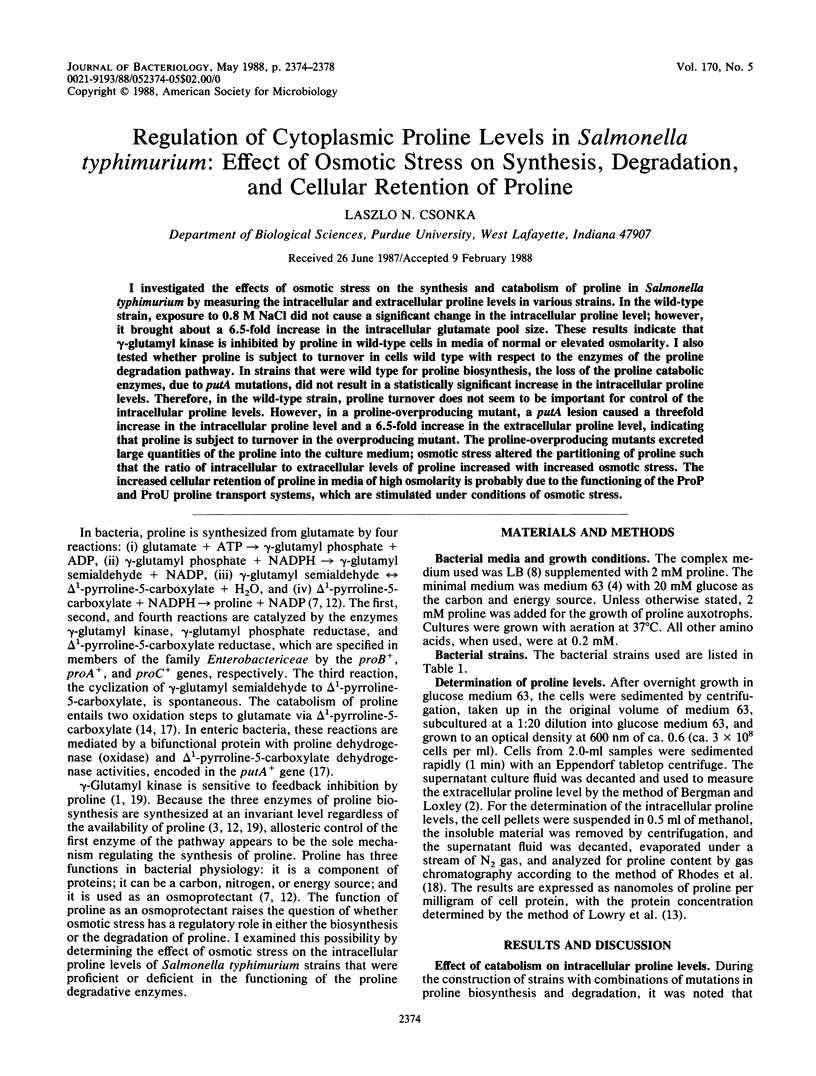
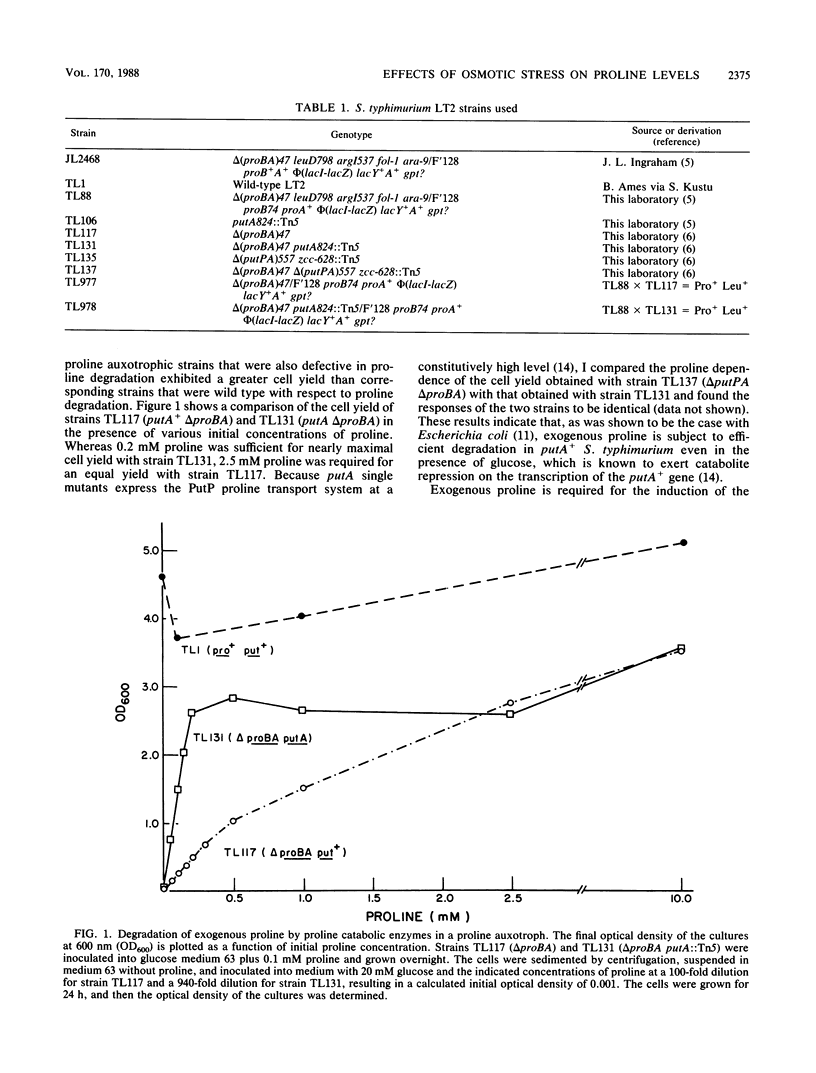
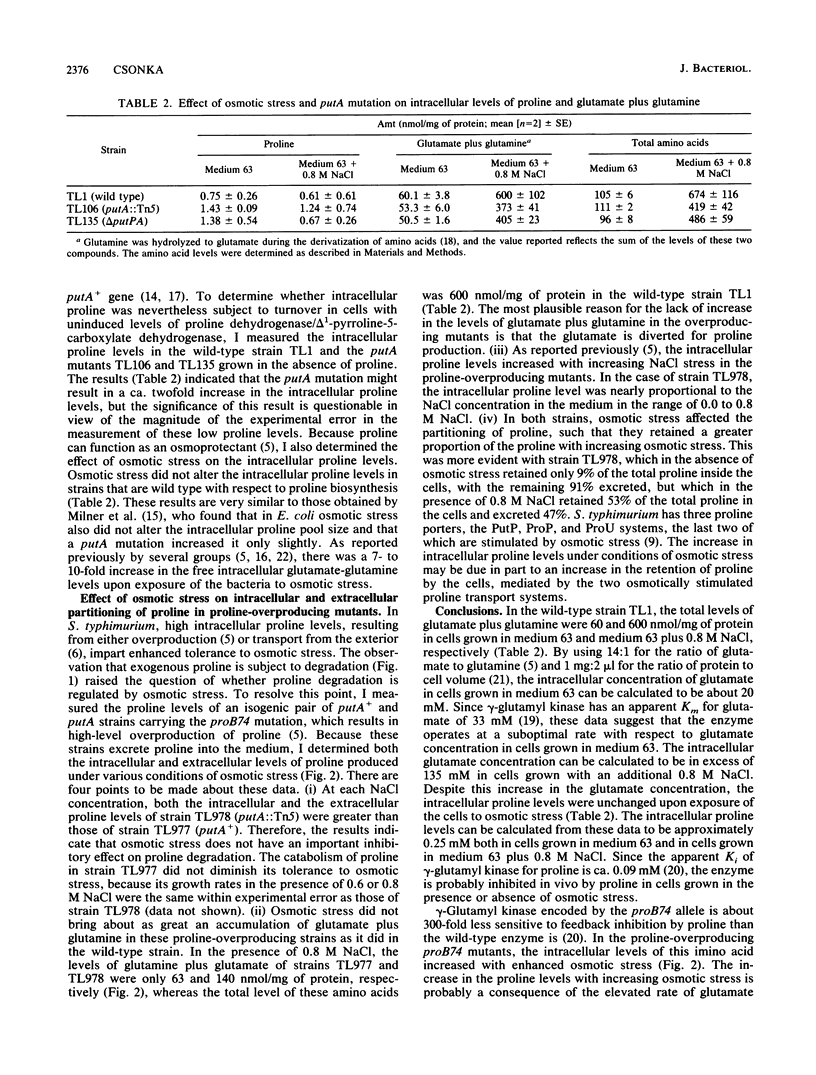
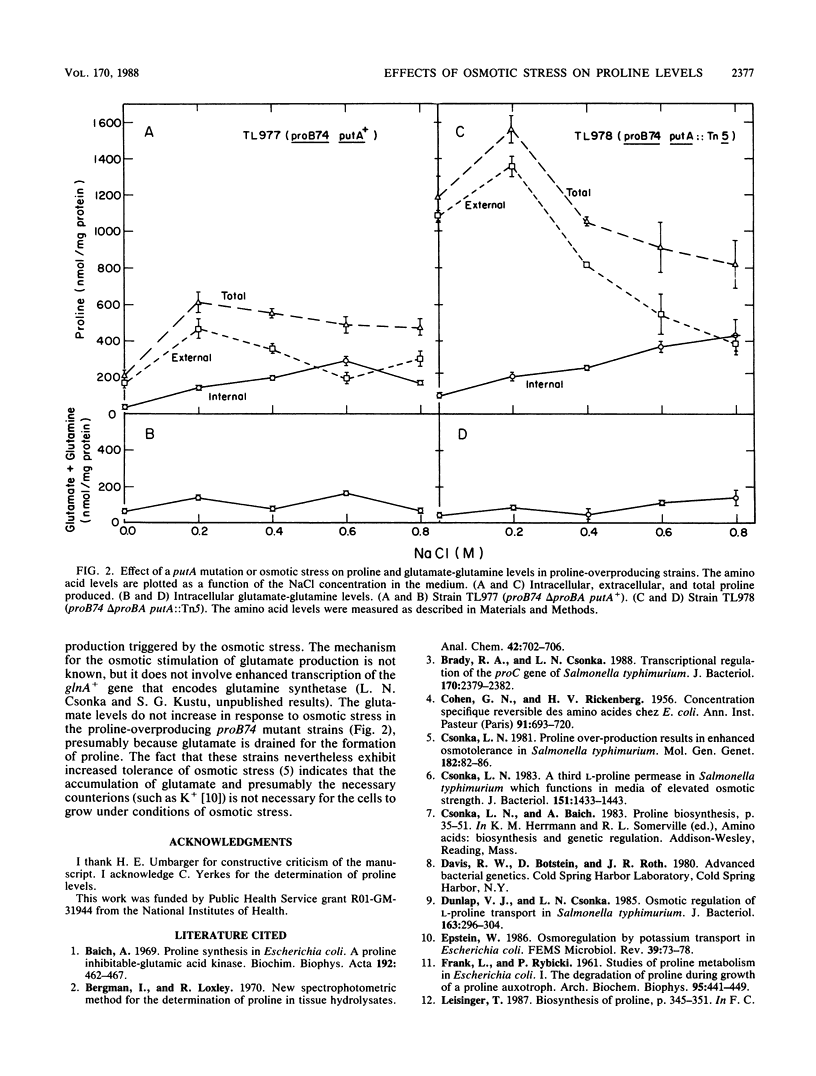
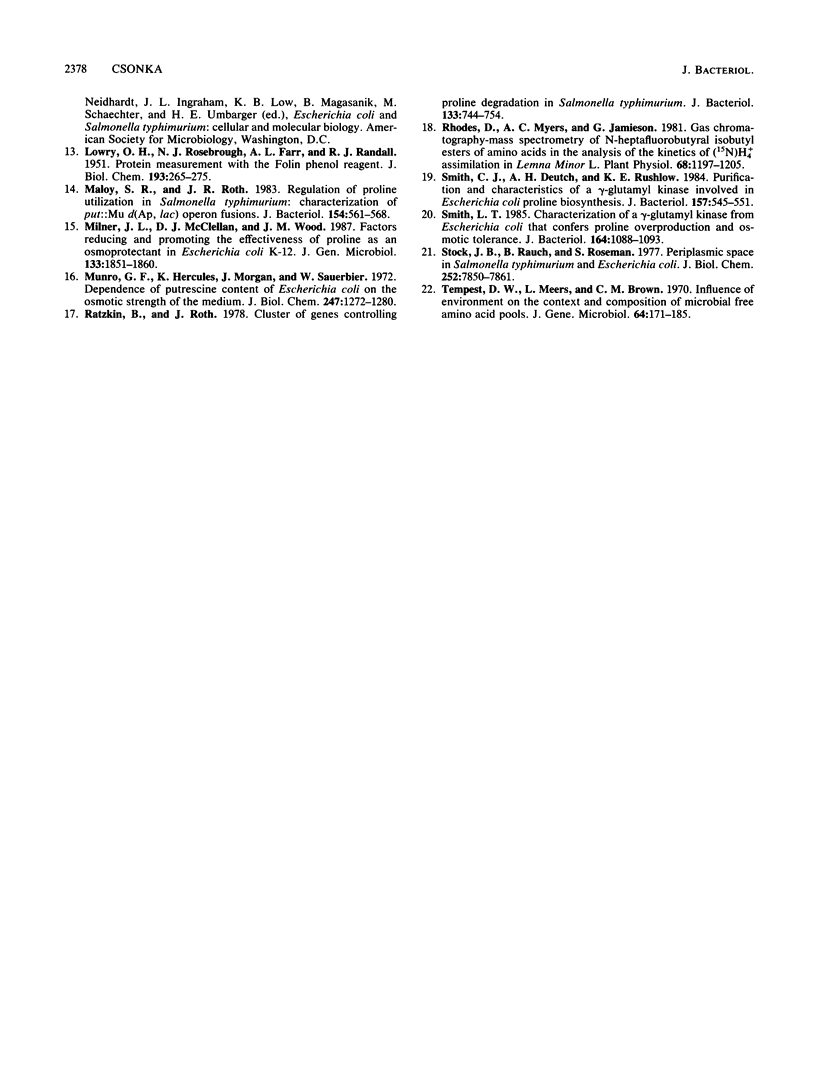
Selected References
These references are in PubMed. This may not be the complete list of references from this article.
- Baich A. Proline synthesis in Escherichia coli. A proline-inhibitable glutamic acid kinase. Biochim Biophys Acta. 1969 Dec 30;192(3):462–467. doi: 10.1016/0304-4165(69)90395-x. [DOI] [PubMed] [Google Scholar]
- Bergman I., Loxley R. New spectrophotometric method for the determination of proline in tissue hydrolyzates. Anal Chem. 1970 Jun;42(7):702–706. doi: 10.1021/ac60289a036. [DOI] [PubMed] [Google Scholar]
- Brady R. A., Csonka L. N. Transcriptional regulation of the proC gene of Salmonella typhimurium. J Bacteriol. 1988 May;170(5):2379–2382. doi: 10.1128/jb.170.5.2379-2382.1988. [DOI] [PMC free article] [PubMed] [Google Scholar]
- COHEN G. N., RICKENBERG H. V. Concentration spécifique réversible des amino acides chez Escherichia coli. Ann Inst Pasteur (Paris) 1956 Nov;91(5):693–720. [PubMed] [Google Scholar]
- Csonka L. N. A third L-proline permease in Salmonella typhimurium which functions in media of elevated osmotic strength. J Bacteriol. 1982 Sep;151(3):1433–1443. doi: 10.1128/jb.151.3.1433-1443.1982. [DOI] [PMC free article] [PubMed] [Google Scholar]
- Csonka L. N. Proline over-production results in enhanced osmotolerance in Salmonella typhimurium. Mol Gen Genet. 1981;182(1):82–86. doi: 10.1007/BF00422771. [DOI] [PubMed] [Google Scholar]
- Dunlap V. J., Csonka L. N. Osmotic regulation of L-proline transport in Salmonella typhimurium. J Bacteriol. 1985 Jul;163(1):296–304. doi: 10.1128/jb.163.1.296-304.1985. [DOI] [PMC free article] [PubMed] [Google Scholar]
- FRANK L., RYBICKI P. Studies of proline metabolism in Escherichia coli. I. The degradation of proline during growth of a proline-requiring auxotroph. Arch Biochem Biophys. 1961 Dec;95:441–449. doi: 10.1016/0003-9861(61)90174-6. [DOI] [PubMed] [Google Scholar]
- LOWRY O. H., ROSEBROUGH N. J., FARR A. L., RANDALL R. J. Protein measurement with the Folin phenol reagent. J Biol Chem. 1951 Nov;193(1):265–275. [PubMed] [Google Scholar]
- Maloy S. R., Roth J. R. Regulation of proline utilization in Salmonella typhimurium: characterization of put::Mu d(Ap, lac) operon fusions. J Bacteriol. 1983 May;154(2):561–568. doi: 10.1128/jb.154.2.561-568.1983. [DOI] [PMC free article] [PubMed] [Google Scholar]
- Milner J. L., McClellan D. J., Wood J. M. Factors reducing and promoting the effectiveness of proline as an osmoprotectant in Escherichia coli K12. J Gen Microbiol. 1987 Jul;133(7):1851–1860. doi: 10.1099/00221287-133-7-1851. [DOI] [PubMed] [Google Scholar]
- Munro G. F., Hercules K., Morgan J., Sauerbier W. Dependence of the putrescine content of Escherichia coli on the osmotic strength of the medium. J Biol Chem. 1972 Feb 25;247(4):1272–1280. [PubMed] [Google Scholar]
- Ratzkin B., Roth J. Cluster of genes controlling proline degradation in Salmonella typhimurium. J Bacteriol. 1978 Feb;133(2):744–754. doi: 10.1128/jb.133.2.744-754.1978. [DOI] [PMC free article] [PubMed] [Google Scholar]
- Rhodes D., Myers A. C., Jamieson G. Gas Chromatography-Mass Spectrometry of N- Heptafluorobutyryl Isobutyl Esters of Amino Acids in the Analysis of the Kinetics of [N]H(4) Assimilation in Lemna minor L. Plant Physiol. 1981 Nov;68(5):1197–1205. doi: 10.1104/pp.68.5.1197. [DOI] [PMC free article] [PubMed] [Google Scholar]
- Smith C. J., Deutch A. H., Rushlow K. E. Purification and characteristics of a gamma-glutamyl kinase involved in Escherichia coli proline biosynthesis. J Bacteriol. 1984 Feb;157(2):545–551. doi: 10.1128/jb.157.2.545-551.1984. [DOI] [PMC free article] [PubMed] [Google Scholar]
- Smith L. T. Characterization of a gamma-glutamyl kinase from Escherichia coli that confers proline overproduction and osmotic tolerance. J Bacteriol. 1985 Dec;164(3):1088–1093. doi: 10.1128/jb.164.3.1088-1093.1985. [DOI] [PMC free article] [PubMed] [Google Scholar]
- Stock J. B., Rauch B., Roseman S. Periplasmic space in Salmonella typhimurium and Escherichia coli. J Biol Chem. 1977 Nov 10;252(21):7850–7861. [PubMed] [Google Scholar]
- Tempest D. W., Meers J. L., Brown C. M. Influence of environment on the content and composition of microbial free amino acid pools. J Gen Microbiol. 1970 Dec;64(2):171–185. doi: 10.1099/00221287-64-2-171. [DOI] [PubMed] [Google Scholar]


